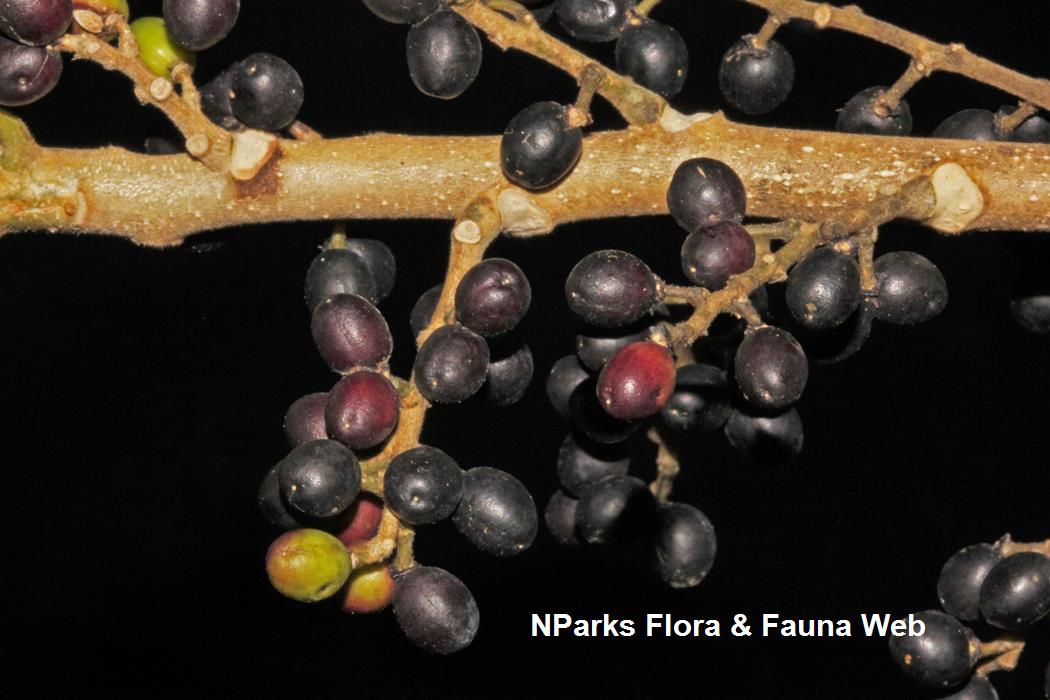_low_res.jpg)
Back
Brucea javanica (L.) Merr.
| Family Name: | Simaroubaceae |
| Synonyms: | Brucea sumatrana Roxb., Brucea amarissima (Lour.) Desv. ex Gomes, Rhus javanica L., Brucea sumatrensis Spreng., Lussa radja Rumph. |
| Common Name: | Lada Pahit, Embalau Padang, Kusum, Melada Pahit, 鸦胆子 |
Name
Classifications and Characteristics
| Plant Division | Angiosperms (Flowering Seed Plants) |
|---|---|
| Plant Growth Form | Shrub, Tree |
| Lifespan (in Singapore) | Perennial |
| Mode of Nutrition | Autotrophic |
| Maximum Height | 10 m |
Biogeography
| Native Distribution | From India, Sri Lanka, Southern China, Southeast Asia and Northern Australia. |
|---|---|
| Native Habitat | Terrestrial |
| Preferred Climate Zone | Tropical |
| Local Conservation Status | Native to Singapore (Critically Endangered (CR)) |
Description and Ethnobotany
| Growth Form | It is a shrub or small tree, up to 10 m tall. |
|---|---|
| Foliage | Leaves are spirally arranged and imparipinnate. Each leaf about 20 – 50 cm long and comprises of 3 – 15 leaflets. Leaflet is ovate-oblong to ovate-lanceolate (3.5 – 11 cm long and 1.5 – 5 cm wide) with toothed margin. Young leaves have dense hairs on the leaf blade and petiole. |
| Flowers | Flowers occurs as an axillary raceme-like inflorescence. They are small, green-white to green red or purple. Flower is unisexual and each has 4 sepals joined at the base, 4 petals and a thick disc with 4 lobes. |
| Fruit | Fruit is a drupe that occurs in cluster of 1 – 4. It is oval to elliptical shaped (0.4 – 0.7 cm long), slightly 2-ribbed and turns purplish black when ripe. Each fruit bears one seed that is yellow-white. |
| Habitat | It is found in secondary forest, sandy dunes and limestone, up to 900 m altitude. <2, 3, 4, 5> |
| Associated Fauna | The flowers are likely pollinated by insects. |
| Etymology | The genus Brucea commemorates James Bruce (1730 – 1794) a Scottish scholar and explorer. The specific epithet javanica, is named after the island Java, in Indonesia, referring to one of the natural geographical distributions of this species. |
| Ethnobotanical Uses | Medicinal: Scientific evidence of medicinal properties It is important to note that some therapeutic effects from traditional medicinal uses of plants are not currently supported or verified by scientific research. Others: The ripe fruits are edible and eaten by the rural eastern Indian community (i.e.Orissa Jharkand state) <1>. |
Fauna, Pollination and Dispersal
| Pollination Method(s) | Biotic (Fauna) |
|---|
Plant Care and Propagation
| Light Preference | Full Sun |
|---|---|
| Water Preference | Moderate Water |
| Plant Growth Rate | Moderate |
References
| References | <1> Adbulwali, A. et al. (2014). Evaluation of antidiabetic and antioxidant properties of Brucea javanica seed. Anticancer Agents Med Chem 14(3): 440-458. <2> de Padua, L.S., Bunyapraphatsara, N. & Lemmens, R.H.M.J. (Editors). 1999. Plant Resources of South-East Asia Volume 5 (2). Timber Trees: Minor commercial timbers. Indonesia Prosea Foundation. 655 pages. Leiden: Backhuys Publishers. <6> Soerianegara, I. & Lemmens, R.H.M.J. (1999). PROSEA, No. 12(1) Medicinal and Poisonous Plants 1, pp.160-161. Leiden: Backhuys Publishers. |
|---|
Image Repository
Others
| Master ID | 33932 |
|---|---|
| Species ID | 8348 |
| Flora Disclaimer | The information in this website has been compiled from reliable sources, such as reference works on medicinal plants. It is not a substitute for medical advice or treatment and NParks does not purport to provide any medical advice. Readers should always consult his/her physician before using or consuming a plant for medicinal purposes. |

_low_res.jpg)
_low_res.jpg)
